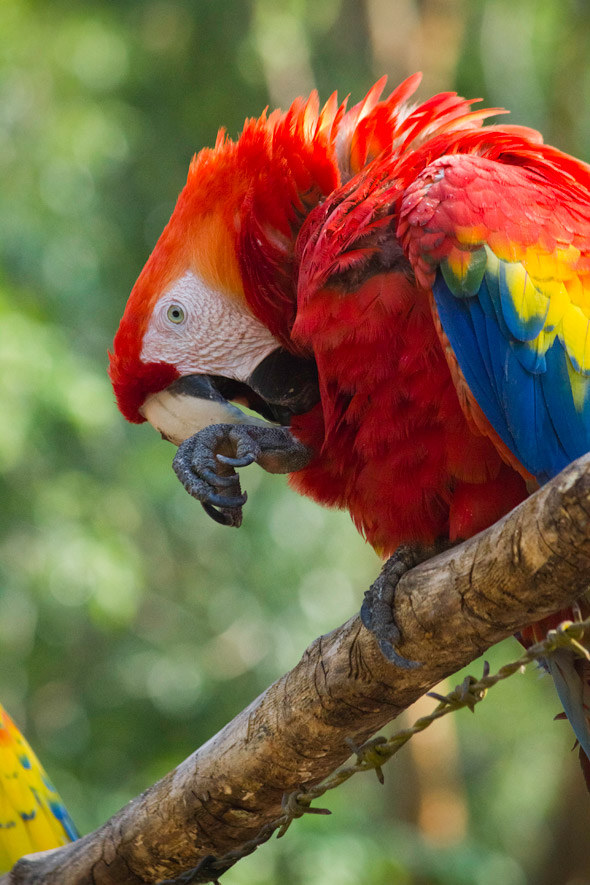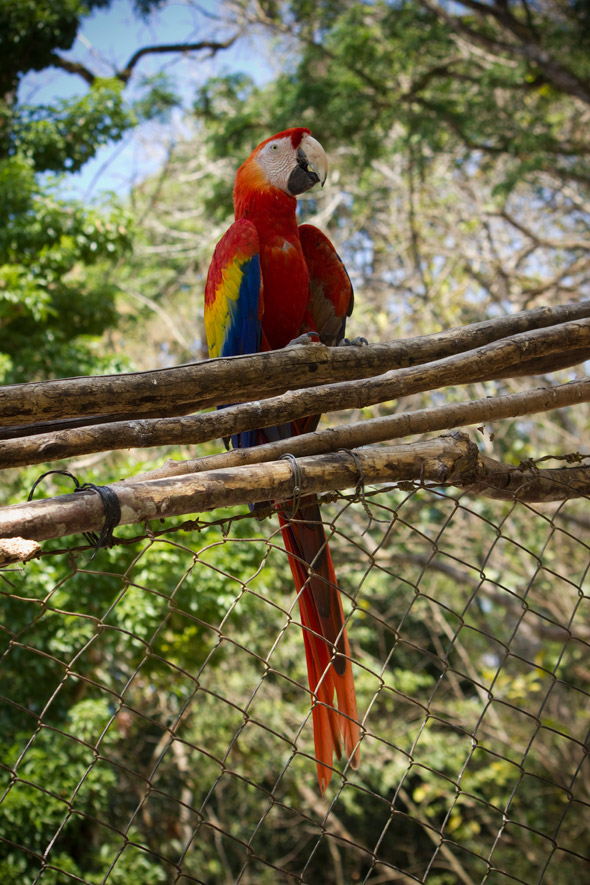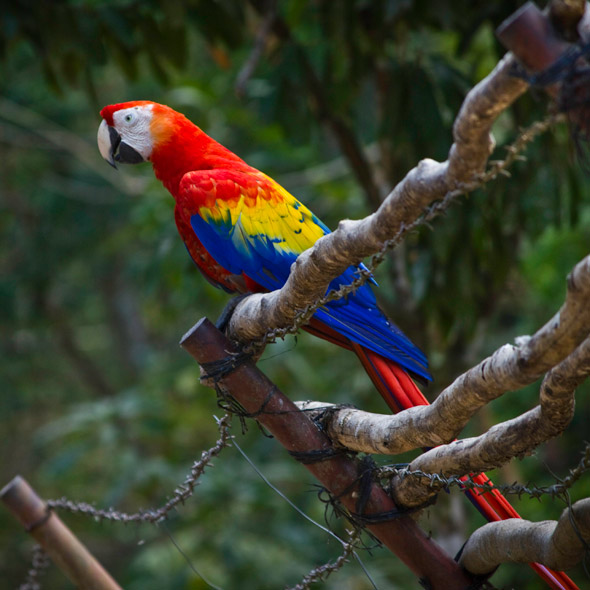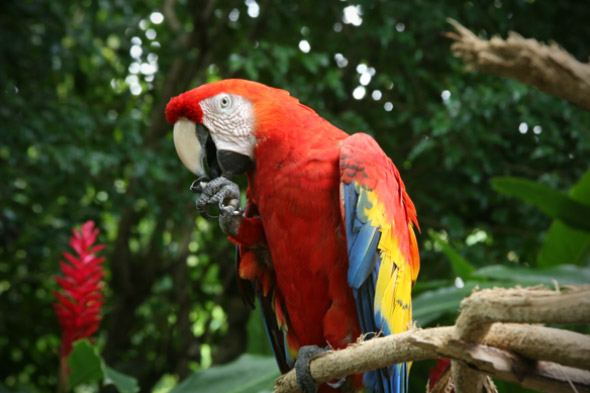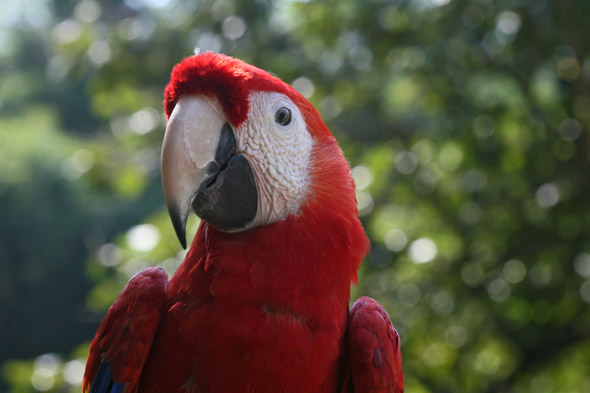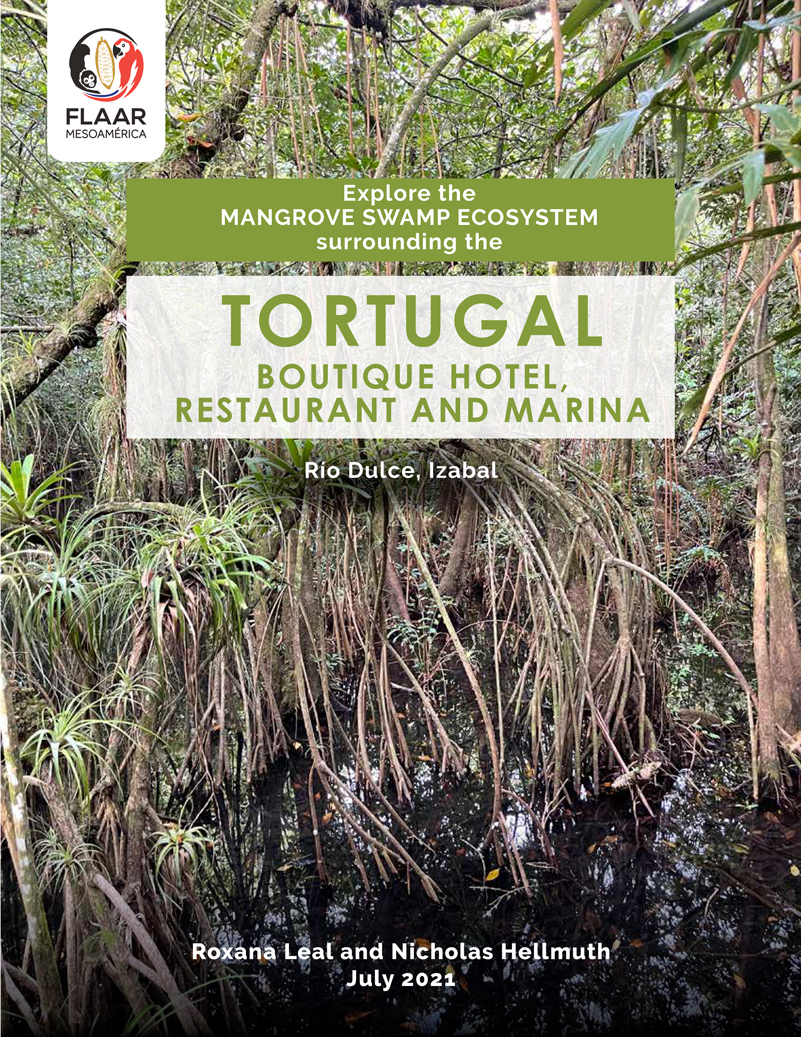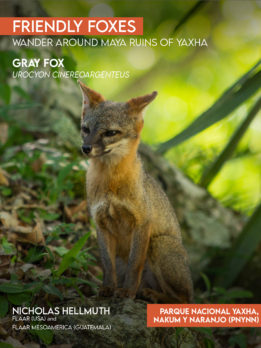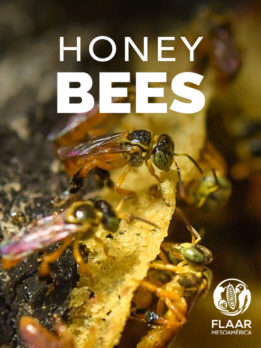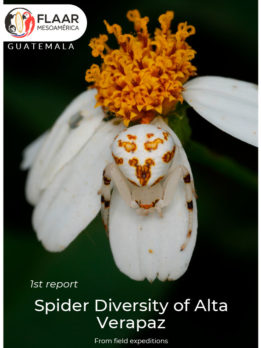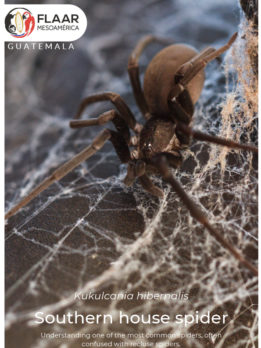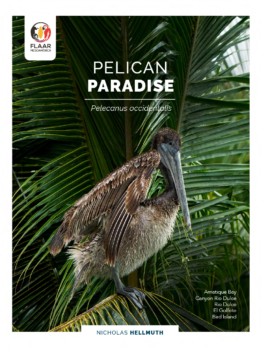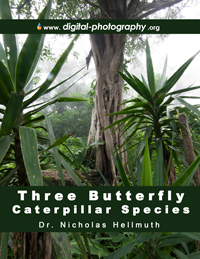The Scarlet macaws
Scarlet macaws one of the most beautiful birds of Latin America. This bird is very important for the environment because they fed in more than 45 plant species. Mostly they feed on fruit and seeds, but they also feed on young leaves, flowers and barks. When Scarlet macaws fly from tree to tree they drop the fruit or the seeds, and they help to disperse the seeds. That is why they have such an important role in the ecosystem.
Scarlet macaw grooming, Ara macao at Copán Honduras. Photo by Sofía Monzón with a Canon EOS Rebel T2i.
According to a study made in Costa Rica by Vaughan (et al 2006) Scarlet macaws feed on various species that contain secondary compounds toxic for human and also for other animals. The toxic secondary compounds were present in the bark, the seeds and also the fruit of the species such as Hura crepitans, Cedrela odorata, Bursera simaruba, and Anacardium occidentalis. In the case of H. crepitans is the sap of the bark the part of the plant that contains a secondary compound toxic to human. Vaughan et al. (2006) reports that the fruits that fell from the tree of H. crepitans were untouched by most wildlife, and they observed that Scarlet macaw eating fruits, seeds and bark of H. crepitans throughout most of the year in Costa Rica. I don't doubt that they have the same behavior along the Neotropics.
Scarlet macaws at Copán, Honduras. Photo by Sofia Monzon using a Canon EOS Rebel T2i. April 2012.
Another plant, that also contained secondary compound toxic to human and that have been reported to be eaten by Scarlet macaws are Cedrela odorata and Bursera simaruba. However these trees not only provided food for the Scarlet macaws, they also provide nesting cavities. The trees that have been reported to be food and nests for Scarlet macaws are Ceiba pentandra, Schizolobium parahybum, H.crepitans and Terminalia oblongata (Vaughan et al 2006).
The Scarlet macaws in the pre-Hispanic period
The Macaw feathers were highly prized items for the pre-Hispanic peoples of Mesoamerica. They had a significant value in rituals, and economically and politically speaking. The colorful and iridescent feathers of tropical birds, especially of the Psittacidae family, were very important. According to Somerville the feathers promote the long distance trade and strategies, like breeding programs, in order to constantly supply feathers. Also Duran says that, during the 1500s AD, the Aztecs were receiving feathers as a polity tribute.
The red feathers of the macaw were very important. Macaw at Copán, Honduras, April 2012.
For many Mesoamericans the red, blue and yellow feathers of the scarlet macaw (Ara macao) were of particular interest. According to Kappelman (2001) this species is associated with rule by shamans in the Itzapa. And Freidel (1993) indicates that the Classic Maya (250-900 AD) depicted the macaw in the stelae and sculptures. The Scarlet macaw feathers were the most used for feather working by the Aztec elite (Somerville 2010).
Threads and actual status
Nowadays Scarlet macaw is still one of the most important among the Psittacidae family, mainly because of wide distribution and the number decline along all the countries were reported. The Scarlet macaw's range is now fragmented causing habitat loss, intense poaching and capturing for pet trade and direct hunting. These causes stress and a low rate reproductive success. Since the direct hunting is a particular threat it has been listed in Appendix I of Cites. This species has been eliminated from the Pacific slope and other areas of its historical distribution (Howell y Webb 1995), there are a lot of places that have a small number of individuals that keep safe from the external threats.
Pet trade and direct hunting are causing a low rate reproductive success, and consequently a general number decline. Ara macao at Copan, April 2012.
In Guatemala, the Wildlife Conservation Society studied the macaw population in Petén and Honduras. According to recent inventories in the Maya Biosphere Reserve almost 80% of the nests of the Scarlet macaw are found in the southeastern section of the Biosphere and in nearby areas.
Almost 80% of the nests of Ara macao are inside the Maya Biosphere.Photo by Sofia Monzon at Copan, April 2012.
One of these places is Auto-Safari Chapin and La Estacion las Guacamayas, in Peten. And also The Copan Ruins, in Honduras. Here at FLAAR we have had the opportunity to take pictures of this amazing bird. We have pictures from Auto-Safari Chapin and recent pictures from The Copan Ruins.
Scarlet macaw at Autosafari Chapin. Photo by Daniela da'Costa, August 2011.
Scarlet macaw at Autosafari Chapin. Photo by Daniela da'Costa, August 2011.
PDF, Articles, Books on Macaws
- 1994
- The History of the Indies on New Spain, University of Oklahoma Press, Norman.
- 2008
- Scarlet Macaw (Ara macao, Psitaciformes: Psittacidae) Nest Characterististics in the Osa Peninsula Conservation Area (ACOSA), Costa Rica. Revista de Biologia Tropical, Vol. 57 (1-2): 387-393
- 1995
- A guide of the birds of Mexico and Northern Central America. Oxford University Press, New York. 851 pages.
- 2001
- Sacred geography at Itzapa and the performance of rulership. In: Koontz, R. Reese-Taylor, K., Headrick, A. Eds. Landscape and Power in Ancient Mesoamerica. Westview Press, Boulder, CO, pp 81-111
- 1999
- Genetic diversity of scarlet macaws Ara macao in reintroduction studies for threatened populations in Costa Rica. Biological Conservation, Vol. 87: 269-272
- 2010
- Isotopic investigation of pre-Hispanic macaw breeding in Northwest Mexico. Journal of Anthropological Archaeology. 29: 125-135
- 2008
- Scarlet Macaw (Ara macao) (Psitaciformes: Psittacidae) Parental Nest Visitation in Costa Rica: Implications for Research and Conservation. Revista de Biologia Tropical, Vol. 57 (1-2): 395-400
- 2006
- Scarlet Macaw (Ara macao) (Psitaciformes: Psittacidae) diet in Central Pacific Costa Rica. Revista de Biologia Tropical, Vol. 574 (3): 919-926
First posted May 31, 2012 by Daniela Da'Costa


